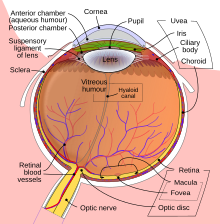This article needs additional citations for verification. (July 2010) |
| Posterior vitreous detachment | |
|---|---|
 | |
| Schematic diagram of the human eye. | |
| Specialty | Ophthalmology |
A posterior vitreous detachment (PVD) is a condition of the eye in which the vitreous membrane separates from the retina.[1] It refers to the separation of the posterior hyaloid membrane from the retina anywhere posterior to the vitreous base (a 3–4 mm wide attachment to the ora serrata).
The condition is common for older adults; over 75% of those over the age of 65 develop it. Although less common among people in their 40s or 50s, the condition is not rare for those individuals. Some research has found that the condition is more common among women.[2][3]
- ^ Gauger E; Chin EK; Sohn EH (17 November 2014). "Vitreous Syneresis: An Impending Posterior Vitreous Detachment (PVD)". University of Iowa Health Care: Ophthalmology and Visual Sciences; See "Discussion" following "Clinical Course".
{{cite web}}: CS1 maint: postscript (link) - ^ Yonemoto, J; Noda, Y; Masuhara, N; Ohno, S (June 1996). "Age of onset of posterior vitreous detachment". Current Opinion in Ophthalmology. 7 (3): 73–6. doi:10.1097/00055735-199606000-00012. PMID 10163464.
- ^ "Posterior vitreous detachment". rnib.org.uk. 2023-02-28. Retrieved 3 November 2015.